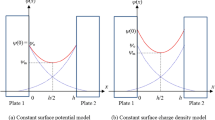Abstract
The adhesion rate of cells under charge regulation onto a rotating disc with constant potential is investigated theoretically in this paper. In particular, the effect of the presence of divalent carions in the suspension medium on adhesion rate of cells is discussed. By using sheep leucocytes as an illustrative example, it is shown that the presence of divalent cations in the suspension medium has the effect of decreasing the adhesion rate of cells. At a fixed level of ionic strength, the adhesion rate decreases with the increase of the concentration of divalent cations in the suspension medium for the various values of Peclet number andAd parameter given in this paper. For a fixed concentration of cations, the adhesion rate increases with the increase of ionic strength. At high ionic strength, the effect of increasing the concentration of cations on decreasing the adhesion rate of cells is not as high as that at low ionic strength. Applying the concept of Donnan potential, it is found that the magnitude of the electrostatic force between an ion-penetrable cell membrane and a solid surface is much smaller than that for the ion-impenetrable cell membrane.
Similar content being viewed by others
Abbreviations
- a:
-
cell radius (cm)
- A:
-
Hamaker's constant (erg)
- Ad :
-
A/kT
- C:
-
dimensionless cell concentration
- D∞ :
-
cell diffusion coefficient (cm2/s)
- e :
-
magnitude of electron charge (statcoul)
- F :
-
dimensionless interaction force between cell and rotating disc pernkT
- h :
-
minimum separation distance between cell surface and disc surface (cm)
- H :
-
dimensionless separation distance between cell surface and disc surfaceh/a
- [H +] r :
-
hydrogen ion concentration in the suspension medium (mole dm−3)
- [H +] s :
-
hydrogen ion concentration on the cell surface (mole dm−3)
- κ:
-
Boltzmann's constant (erg K−1)
- K a :
-
dissociation equilibrium constant for acid groups on cell surface (mole dm−3)
- K b :
-
dissociation equilibrium constant for base groups on cell surface (mole dm−3)
- n :
-
ionic strength in the suspension medium (ions cm−3
- Pe :
-
Peclet number
- q :
-
valence of cations
- Sa :
-
the reciprocal of acidic density on the cell surface (cm2/group)
- S b :
-
the reciprocal of basic density on the cell surface (cm2/group)
- Sh :
-
Sherwood number
- T :
-
absolute temperature (K)
- η:
-
the fraction of cationic electrolyte in the suspension medium, 0≤η≤1
- ϰ:
-
reciprocal of Debye length, (cm−1)
- ν:
-
fluid kinematic viscosity (cm2/s)
- τ:
-
ϰ×a
- l :
-
distance between two plate surfaces in Derjuguin's model (cm)
- φ:
-
dimensionless total interaction energy between cell surface and disc surface
- φvdw :
-
dimensionless unretarded van der Waals potential between cell surface and disc surface
- φDL :
-
dimensionless double-layer interaction potential between cell surface and disc surface
- ψ:
-
dimensionless electrostatic potential between cell surface and disc surface
- ω:
-
rotating speed of the disc (rad/s)
References
Berkeley RCW, Lynch JM, Melling J, Rutter PR, Vincent B (1980) Microbial Adhesion to Surfaces. Ellis Horwood. Chichester
Marshall KC (1984) Microbial Adhesion and Aggregation, Springer-Verlag, Berlin
Verwey EJW, Overbeek JThG (1948) Theory of the Stability of Lyophobic Colloids Elsevier, Amsterdam
Jang LK (1984) PhD Thesis. University of Southern California
Ninham BW, Parsegian VA (1971) J Theor Biol 31:405–428
Chan D, Perram JW, White LR, Healy TW (1975) J Chem Soc Faraday Trans I 71:1046–1057
Prieve DC, Ruckenstein E (1977) J Colloid Interface Sci 60:337–348
Chang YI (1989) Colloids and Surfaces 41:245–254
Chang YI (1989) J Theor Biol 139:561–571
Prieve DC, Ruckenstein E (1978) J Colloid Interface Sci 63:317–329
Levich VG (1962) Physiochemical Hydrodynamics. Prentice-Hall, New Jersey
Marshall JK, Kitchener JA (1966) J Colloid Interface Sci 22:342–351
Hull M, Kitchener JA (1969) Trans Faraday Soc 65:3093–3104
Prieve DC (1974) PhD Thesis. University of Delaware
Brenner H (1961) Chem Eng Sci 16:242–251
Goren SL (1973) J Colloid Interface. Sci 44:356–365
Goldman AJ, Cox RG, Brenner H (1967) Chem Eng Sci 22:637–651
Hamaker HC (1937) Physica 4:1058–1072
Derjaguin BV (1954) Discuss Faraday Soc 18:85–98
Prieve DC, Lin JM (1980) J Colloid Interface Sci 76:32–47
Prieve DC, Ruckenstein E (1976) J Theor Boil 56:205–228
Ohshima H, Kondo T (1987) J Theor Biol 128:187–194
Ohshima H, Kondo T (1988) J Colloid Interface Sci 123:136–142
Terui H, Taguchi T, Ohshima H, Kondo T (1990) Colloid Polym Sci 268:76–82
Taguchi T, Terui H, Ohshima H, Kondo T (1990) Colloid Polym Sci 268:83–87
Levine S, Levine M, Sharp KA, Brooks DE (1983) Biophys J 42:127–135
Bell GI, Dembo M, Bongrand P (1984) Biophys J 45:1051–1064




